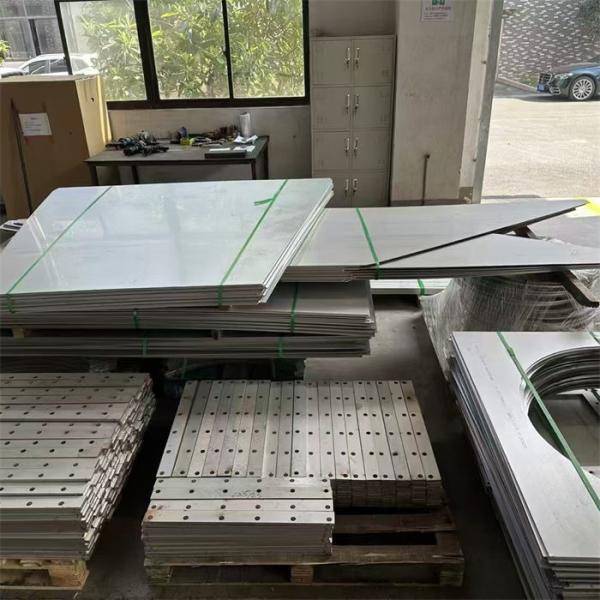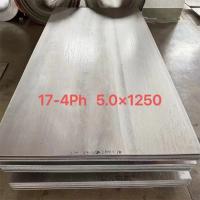AISI 316L stainless steel plate UNS S31603 plate cut round plate
for chemical marine 10-50mm.
316L stainless steel is a low-carbon austenitic stainless steel
with excellent corrosion resistance due to the addition of
molybdenum (Mo) element. Compared with other stainless steel
materials, 316L stainless steel exhibits extremely high corrosion
resistance in chloride environments, and is particularly suitable
for marine environments and chemical industries. In addition, 316L
stainless steel is low-carbonized, not prone to intergranular
corrosion, and has good oxidation resistance. These characteristics
enable 316L stainless steel to maintain good mechanical properties
and corrosion resistance even in high-temperature environments,
making it suitable for high-temperature equipment and pipelines.
316L is widely used in the chemical industry due to its excellent
corrosion resistance. 316L is also a derivative steel of 18-8
austenitic stainless steel, with 2-3% Mo added. Based on 316L, many
steel grades are also derived, such as 316Ti derived by adding a
small amount of Ti, 316N derived by adding a small amount of N, and
317L derived by increasing the Ni and Mo content.
Most of the existing 316L on the market are produced according to
the American standard. For cost considerations, steel mills
generally keep the Ni content of the product as low as possible.
The American standard stipulates that the Ni content of 316L is
10-14%, while the Japanese standard stipulates that the Ni content
of 316L is 12-15%. According to the lowest standard, there is a 2%
difference in Ni content between the American standard and the
Japanese standard, which is still quite huge in price, so customers
still need to see clearly when purchasing 316L products, whether
the product refers to ASTM or JIS standards.
The Mo content of 316L makes this steel have excellent corrosion
resistance and can be safely used in environments containing
halogen ions such as Cl-. Since 316L is mainly used for its
chemical properties, steel mills have slightly lower surface
inspection requirements for 316L (relative to 304), and customers
with higher surface requirements should strengthen surface
inspection efforts.
316L stainless steel plate is a low-carbon austenitic stainless
steel with excellent corrosion resistance and good mechanical
properties. Its chemical composition includes carbon (C) ≤ 0.030%,
silicon (Si) ≤ 1.00%, manganese (Mn) ≤ 2.00%, sulfur (S) ≤ 0.030%,
phosphorus (P) ≤ 0.045%, chromium (Cr) 16.00 ~ 18.00%, nickel (Ni)
10.00 ~ 14.00%, molybdenum (Mo) 2.00 ~ 3.00%.
Features
| C | Si | Mn | S | P | Cr | Ni | Mo |
| ≤ 0.030% | ≤ 1.00%, | ≤ 2.00% | ≤ 0.030% | ≤ 0.045% | 16.00 ~ 18.00% | 10.00 ~ 14.00% | 2.00 ~ 3.00% |
Tensile strength σb (MPa): ≥480
Conditional yield strength σ0.2 (MPa): ≥177
Elongation δ5 (%): ≥40
Shrinkage ψ (%): ≥60
Hardness: ≤187HB; ≤90HRB; ≤200HV
Density: 7.98g/cm3;
Specific heat capacity ratio (20℃): 0.502J/(g*K)
Thermal conductivity(W/(m*K)) |
100℃ | 300℃ | 500℃ |
15.1 | 18.4 | 20.9 |
316L stainless steel has excellent corrosion resistance due to the
addition of molybdenum (Mo) element, especially in chloride
environment. It also has good oxidation resistance and
intergranular corrosion resistance, suitable for high temperature
environment and harsh chemical environment. In addition, 316L
stainless steel is not prone to intergranular corrosion after low
carbonization treatment, and can maintain good mechanical
properties and corrosion resistance at high temperature.
Application fields
Chemical industry: 316L stainless steel is widely used in the
production of fertilizers, petrochemicals, synthetic fibers, etc.
due to its excellent acid and alkali resistance. It is used to
manufacture corrosion-resistant pipes, containers, heat exchangers
and other equipment.
Marine engineering: Due to its excellent seawater corrosion
resistance, 316L stainless steel is used to manufacture key
components of ships, structural parts and piping systems of
offshore platforms to ensure the safety and reliability of marine
facilities in harsh environments.
Food processing: 316L stainless steel is widely used in the
manufacture of food processing equipment and containers such as
agitators, conveyor belts, storage tanks, etc. due to its hygiene
and corrosion resistance.
Other fields: It is also used in cookware, tableware, daily
hardware, surgical instruments, major electrical appliances,
industrial equipment, automobiles, aerospace and other fields.
Processing and maintenance
316L stainless steel cannot be strengthened by heat treatment, nor
does it require post-weld annealing. It has excellent work
hardening properties and is non-magnetic, making it suitable for
manufacturing parts of various complex shapes.
In terms of maintenance, care should be taken to avoid prolonged
exposure to extreme temperatures and corrosive media, and to
regularly inspect and maintain the equipment to ensure its
long-term stable operation.










